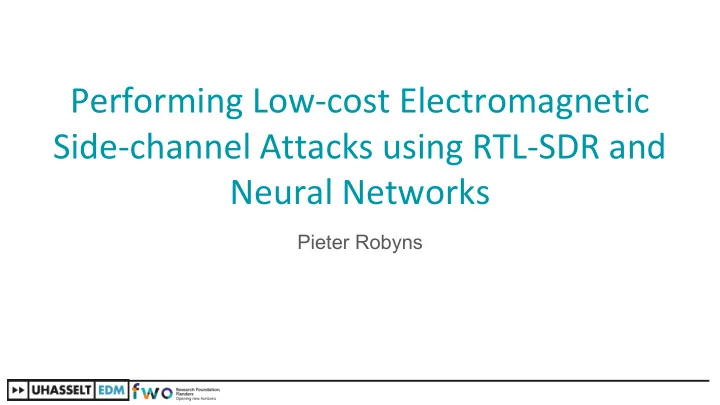

Performing Low-cost Electromagnetic Side-channel Attacks using RTL-SDR and Neural Networks Pieter Robyns
Motivation and introduction
Motivation • Information about performing EM side-channel attacks using SDR is quite scarce – A few academic papers, but code is often closed source – ChipWhisperer: open source, good info on side-channel attacks, but uses custom hardware for power side channels • This talk: how to get started using RTL-SDR and open-source software – We’ll use the EMMA framework (open source since november 2018) • Extra: fun use case for some machine learning
Introduction: the EM side channel • Hardware emits EM radiation during computations – Amplitude of emitted EM wave is proportional to power consumed – Some computations require more power than others • EM side-channel attacks attempt to infer the performed computations from leaked EM radiation • Interesting examples: – Operations of an encryption algorithm during a browser session – Key presses while typing on a keyboard – Memory reads / writes
Introduction: attacks in previous works • Sniffing keystrokes from keyboard emanations – https://www.usenix.org/event/sec09/tech/full_papers/vuagnoux.pdf • Extracting RSA / ElGamal keys from a PC – https://eprint.iacr.org/2015/170.pdf • Or even CRT / LCD screens – https://www.cl.cam.ac.uk/~mgk25/ih98-tempest.pdf • …
Introduction: typical EM side-channel attack scenario 1. (Attacker sends plaintext to encrypt) 2. Victim inadvertently leaks EM radiation during computations 3. Attacker captures signals and infers the used encryption key through statistical analysis Icons made by Freepik from www.flaticon.com
Correlation Electromagnetic Analysis (CEMA) on AES
Performing a standard CEMA on AES • First, find out where the secret key is used https://upload.wikimedia.org/wikipedia/commons/thumb/a/ad/AES-AddRoundKey.svg/2000px-AES-AddRoundKey.svg.png Source: The Design of Rijndael, Joan Daemen and Vincent Rijmen, Springer, 2002. Source: http://doi.ieeecomputersociety.org/cms/Computer.org/dl/trans/tc/2013/03/figures/ttc20130305361.gif
Performing a standard CEMA on AES • Output of SubBytes is loaded to register → leaks https://upload.wikimedia.org/wikipedia/commons/thumb/a/a4/AES-SubBytes.svg/1200px-AES-SubBytes.svg.png Source: http://doi.ieeecomputersociety.org/cms/Computer.org/dl/trans/tc/2013/03/figures/ttc20130305361.gif
Performing a standard CEMA on AES • What happens inside the chip? – CPU register is in unknown initial reference state – After AddRoundKey + SubBytes, the register is where is the index of the considered key byte • Power consumed depends on number of bit flips – Therefore, it’s given by Hamming distance between and 00100110 Hamming Distance = 4 10101000 • Hamming weight also works in practice if R = 0
Performing a standard CEMA on AES • For iterations (encryptions): 0x00 0 Simulate 0x01 1 leakage for each possible ... key byte value 0xff 255 Use random plaintexts to increase variability in resulting Hamming weights
Performing a standard CEMA on AES • Final step: correlate reality with model for each sample • Highest correlation hypothesis is most likely key byte • Absolute value of Pearson correlation – Note: = negative or positive linear correlation! • “Correlation Power Attack”
Case study: AES CEMA attack on Arduino Duemilanove
Overview of the experiment 1. Measurement setup 2. Identifying leaking frequencies 3. Capturing leakage traces using RTL-SDR 4. Performing a standard CEMA on AES 5. Improving CEMA using neural networks
1. Measurement setup • Our target: Arduino Duemilanove – Assuming software AES implementation black box: user supplies plaintext and the device encrypts it with an unknown key • RTL-SDR to perform EM leakage measurements • EM probe / directional antenna + amp • Laptop + GNU Radio + numpy for signal processing
TekBox wideband amp. + 1. Measurement setup probe (€ 287-331) • Probe position: near VCC and GND pins (better quality signal) RTL-SDR (€ 20)
1. Measurement setup
2. Identifying leaking frequencies • Next, let the device encrypt some random plaintexts at regular intervals – Allows us to see which frequencies leak information Encryption operations Idle
2. Identifying leaking frequencies • Let’s zoom in...
3. Capturing leakage traces using RTL-SDR • Host: using emcap from the EMMA framework: ./emcap.py --sample-rate 2000000 --frequency 70720300 --gain 20 --limit 51200 --output-dir datasets/fosdem-arduino-test rtlsdr serial • Instruct target to perform random plaintext encryptions, but with the same key: b1 d3 44 d0 19 ea b4 71 39 d8 3c f2 c2 02 f1 c1
3. Capturing leakage traces using RTL-SDR • Plot the data: ./emma.py abs plot fosdem-arduino-test --plot-num-traces 2 Encryption operations (not aligned)
3. Capturing leakage traces using RTL-SDR ./emma.py abs 'align[15460,15680,True]' filter plot • Align the data: fosdem-arduino-test --plot-num-traces 10 aes128_init(key, &ctx); Magnitude aes128_enc(data, &ctx); Samples
Recommend
More recommend